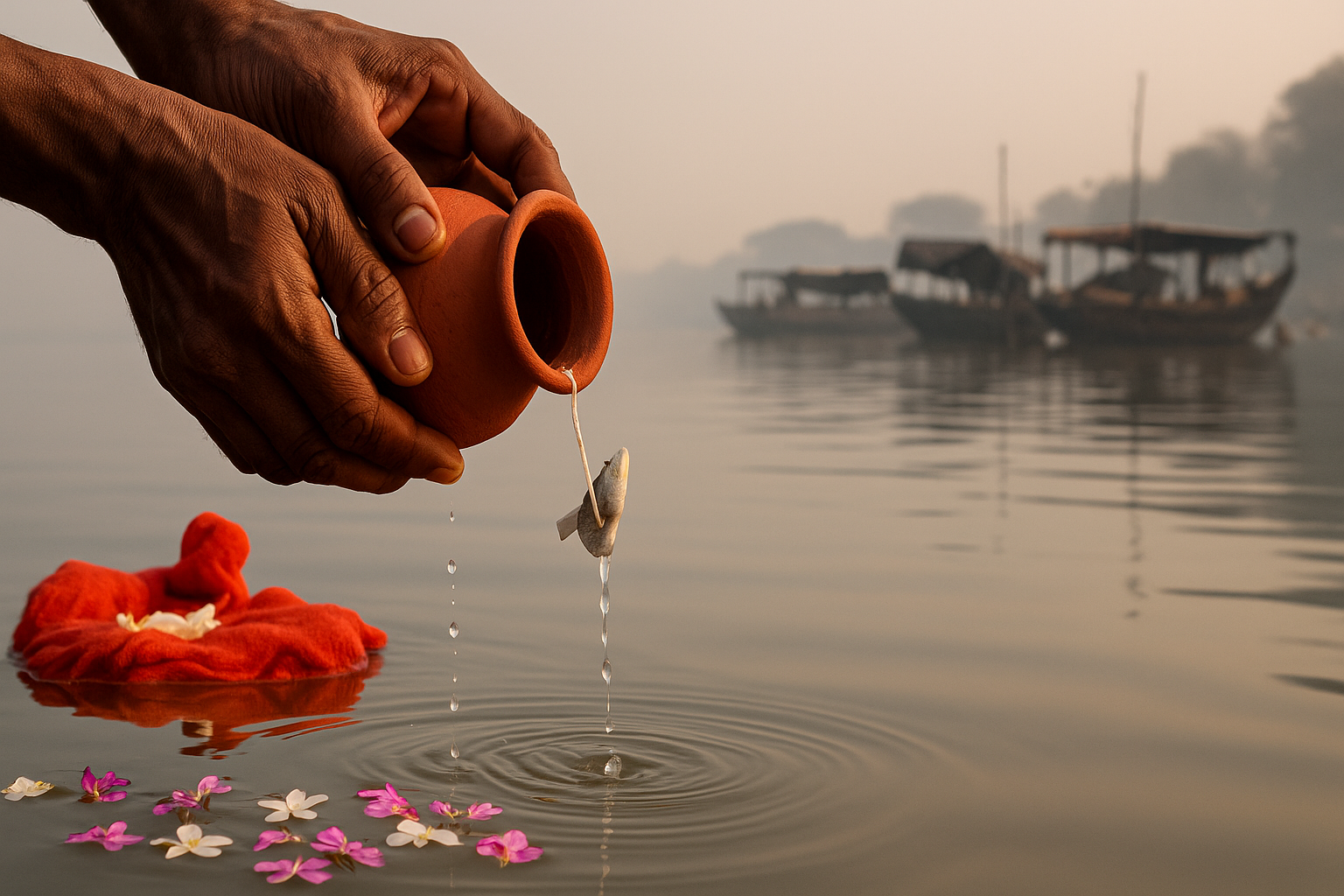Asthi Visarjan Puja
Home / Asthi Visarjan Puja
🔱 Asthi Visarjan Puja

Asthi Visarjan Puja: Last rites to provide salvation to ancestors
According to Hindu scriptures, last rites (Antyeshti) have special importance among the sixteen rites of human life. Another important and final step that remains after the funeral rites is Asthi Visarjan Puja. Through which an attempt is made to free the soul of the deceased from the cycle of rebirth and attain salvation.
Meaning and importance of Asthi Visarjan
'Asthi' means 'bones' and 'Visarjan' means 'to flow in water' or 'to dedicate'. After the body is burnt in the funeral fire, the process of flowing the remains (small pieces of bones and ashes) in a holy river is called Asthi Visarjan.
Its religious and spiritual significance is very deep:
1. Path to attain salvation: It is believed that after death the soul takes on a subtle body which remains connected to these bones. The immersion of these ashes in a holy river (especially Ganga) breaks this bondage and liberates the soul and leads it to salvation.
2. Merger in Panchtatva: According to Hindu philosophy, the human body is made up of Panchtatva (earth, water, fire, air, sky). After the cremation, most of the body dissolves in the fire element. Complete merging of the body with the Panchtatva is ensured by dedicating the remaining remains to the water element through Asthi Visarjan.
3. Freedom from Pitra Rin: It is believed that it is the duty of the children to pave the way for the peace of the soul of their ancestors by duly immersing their ashes. This is a way of repaying the Pitra Rin.
Proper period of Asthi Visarjan
Traditionally, Asthi Visarjan is done either immediately after the funeral or after the thirteenth day (Teervi). For 10 to 13 days after death, the soul wanders in the Pretyoni and gets peace through these deeds. Therefore, there is often a tradition to go for Asthi Visarjan only after the completion of the Shradh Karma on the thirteenth day. However, nowadays due to distance and other arrangements, people do it after a year or even on a special occasion, but in the scriptures, early immersion is considered appropriate.
· The ashes are kept in a new white cloth or a Kalash (pot).
· Black sesame seeds, barley, rice and flowers are also kept along with it.
· The family members wear white clothes and take a pledge to complete this ritual with reverence and calm.
· The family members take the ashes to the bank of a holy river (like Ganga, Yamuna, Godavari, Narmada, Sangam etc.)
· The river Ganga is considered the most sacred, as it is believed that the ashes immersed in the Ganga reach directly to the feet of Lord Vishnu and the soul attains salvation.
.Before immersion, a ritualistic worship is performed by a qualified Brahmin/Pandit on the banks of the river.
· First, Mother Ganga or the deity of that river is invoked and prayed to accept the soul of the deceased.
· Tarpan (water offering) is given to them while pronouncing the name and gotra of the deceased.
· After this, pinda daan is performed. Pinda made of rice flour is offered along with the ashes, which is considered food for the subtle body of the deceased.
· After the puja, the urn of ashes is immersed in the water of the holy river by taking it in the hand, taking the name of the deceased and pronouncing Om.
· After immersion, one takes a bath in the river and performs charity.
Major places for bone immersion
Some places in India are considered extremely sacred for bone immersion:
1. Haridwar, Uttarakhand: Situated on the banks of the river Ganges, Haridwar is called 'Gate of Heaven, Gate of Hari, City of Moksha'.
2. Varanasi, Uttar Pradesh: It is believed that death in Kashi or immersion of bones here leads to direct salvation.
3. Prayagraj, Uttar Pradesh: Asthi immersion at the confluence of Ganga, Yamuna and Saraswati has special significance.
4. Gaya, Bihar: Immersion is also done in the Falgu river in Gaya, famous for Pind Daan.
📌 Puja Highlights
- Price: ₹4,100
- Liberation of the Soul – Immersing ashes in holy rivers frees the soul from worldly bondage and helps attain Moksha.
- Merges with Panchtatva – Completes the final journey by merging the remains with the five natural elements.
- Freedom from Pitra Rin – Fulfills the sacred duty of descendants towards ancestors, ensuring blessings for the family.
- Holy Pilgrimage Sites – Haridwar, Varanasi, Prayagraj, and Gaya are considered most sacred for Asthi immersion.
- Brings Peace & Positivity – Removes spiritual unrest, ensures peace for the departed, and harmony for the family.
